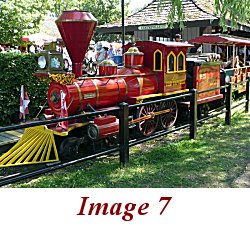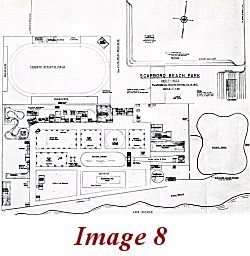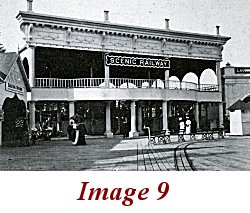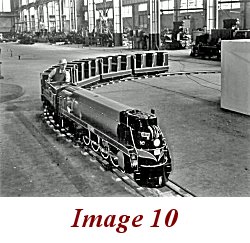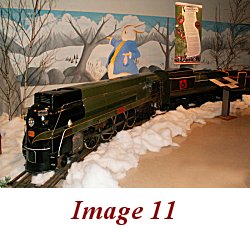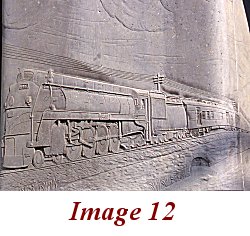Click an image to see a larger version
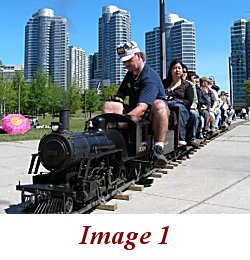
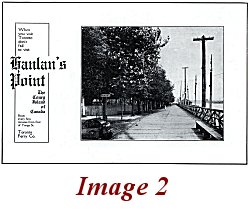
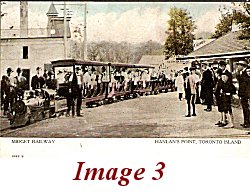
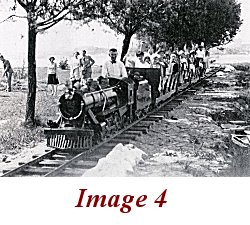
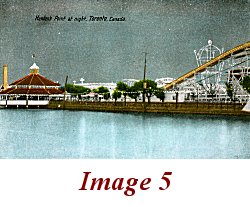
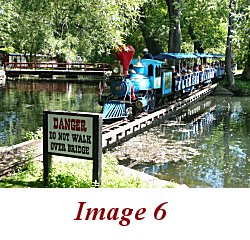
| |
One of the feature attractions proposed for the Toronto Railway Museum at the John Street Roundhouse is a permanent operating miniature railway running through Roundhouse Park. While the track plan is still being finalized, an extensive operation is planned to bring animation and live steam to the museum site. Children and adults have always been fascinated by miniature trains, especially if they're large enough to ride on.
For the past several years, a temporary miniature railway has been one of the most popular features of the annual Doors Open event held at the Roundhouse during the last weekend in May. Toronto Railway Historical Association volunteers install track in an area near the turntable and visitors are able to ride the trains back and forth. This has proven to be one of the most popular and family friendly attractions at Doors Open. (Image #1)
Miniature railways have a long history in Toronto and date back to at least the turn of the 20th century. They were generally called "scenic" or "midget" railways and were especially popular in amusement parks such as Hanlan's Point on Toronto Island. At the time, railways played a much more important role in people's lives than they do today. Almost all inter-city travel was by rail and the public was entranced by miniature versions of the fast trains that whisked them from one place to another.
Hanlan's Point was a full scale amusement park with numerous rides and attractions as well as the site of the stadium used by Toronto's baseball team. Babe Ruth hit his first professional home run there in 1914, an event commemorated by a Heritage Toronto plaque installed in 2007.
These images show the Island scenic railway as it existed a century ago. Image #2 is an advertisement published in a 1906 magazine titled "Toronto the Prosperous." Notice the track running along the left side of the boardwalk and the engine on the lower left. Image #3 provides a better view of the train used in this operation and Image #4 appears to have been taken in the 1920s judging by the clothing styles.
Image #5 is a postcard that purports to show Hanlan's Point at night. In fact, film speeds at the time weren't sufficient to capture a scene like this and night views were actually hand-tinted and heavily retouched daytime photographs. The scenic railway ran adjacent to the boardwalk clearly seen at the water's edge. With the opening of Sunnyside Amusement Park in 1922 and the relocation of the ball team to the mainland, business declined at Hanlan's Point and the amusement park was demolished in the 1930s.
However, the Centreville miniature railway continues to operate at Centre Island during the summer months. Two trains, one painted blue (Image #6) and the other red (Image #7), operate along an extensive track system that weaves through the various rides and concessions. Long line-ups to board the trains on summer weekends testify to the continuing popularity of miniature railways.
Another popular Toronto amusement park was Scarboro Beach, which was in operation from 1907-1922. This facility was acquired by the Toronto Railway Company in 1912 and functioned as a "trolley park." These parks were found throughout North America and were used by local trolley lines as a way of utilizing their fleets of otherwise inactive streetcars during evenings, weekends and holidays.
Image #8 is a map of Scarboro Beach when it was in operation and there are two railways indicated. The first is the "scenic railway" on the left underneath the athletic field. On the right of the map, surrounding the picnic area, is the "miniature steam railway (narrow gauge)."
Image #9 purports to show a "station" for the scenic railway, and again using the clothing styles as a guide, this view appears to have been taken around 1910 shortly after the park opened. There is some question if this view was even taken at Scarboro Beach and it may be a photo of Dominion Park in Montreal since it was owned by the same company as Scarboro Beach. When the Toronto Railway Company was acquired by the Toronto Transportation Commission in 1921, Scarboro Beach was not one of the properties included and the park was demolished and turned into a housing development.
Another popular miniature railway remembered fondly by Torontonians who grew up in the years following World War II was the Toyland Treasure Train at Eaton's department store on Queen Street. The train was hauled by a replica of Canadian National Railway's streamlined No. 6400 steam locomotive introduced in 1936 and still the most modern passenger engine in Canada, since new locomotive development had virtually halted during the war. The scale locomotive was built by CN's Point St. Charles shops (Image #10) in Montreal as they geared down from war production and were preparing the transition back to peacetime. Children paid a quarter to ride the train through the Rocky Mountain Scenic Canyon, Doll Land, Topsy Turvy Town and Santa's Northland Castle. In 1956, Eaton's replaced the engine with a miniature diesel locomotive. The original 6400 replica is now on display at the Canadian Railway Museum near Montreal. (Image #11). Interestingly, a bas-relief carving of 6400, created around the same time as the miniature, can be seen in an alcove on the south wall of the Air Canada Centre. (Image #12)
There also appears to have been a miniature railway at Sunnyside Amusement Park, demolished in the 1950s to make way for the Gardiner Expressway. Mike Filey mentions the railway in his book on Sunnyside but I've been unable to find any photographs or information. If anyone has further information on this or any of the railways mentioned here, please email me at: derekboles@rogers.com.
The future of miniature railway in Toronto is looking very bright indeed. An extensive system is now under construction for the Toronto Railway Museum at Roundhouse Park and will be one of the showpieces of the new rail museum. Given its location, we expect that the railway will become a prime tourist attraction in downtown Toronto.
Written by Derek Boles, TRHA Historian, who retains copyright on the written content, which is not to be reproduced without permission.
|



